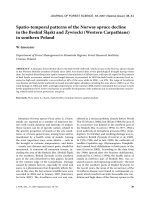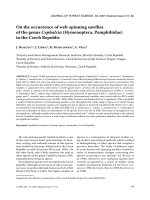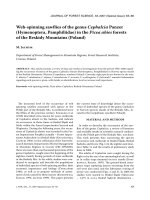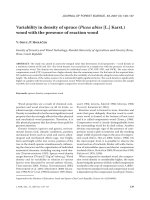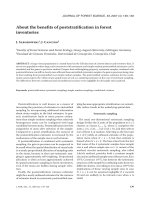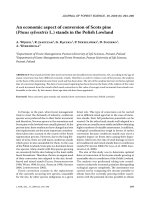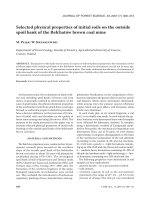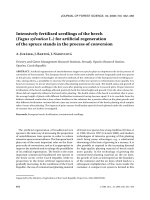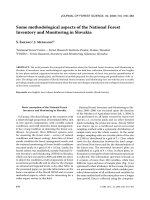Báo cáo lâm nghiệp: " Modelling the influence of winter frosts the development of the stem canker of red oak, caused by Phytophthora cinnamomi" doc
Bạn đang xem bản rút gọn của tài liệu. Xem và tải ngay bản đầy đủ của tài liệu tại đây (871.07 KB, 14 trang )
Original
article
Modelling
the
influence
of
winter
frosts
on
the
development
of
the
stem
canker
of
red
oak,
caused
by
Phytophthora
cinnamomi
B
Marçais
F
Dupuis
ML
Desprez-Loustau
2
1
Laboratoire
de
pathologie
forestière,
Centre
de
Nancy,
Inra,
54280
Champenoux;
2
Laboratoire
de
pathologie
forestière,
Centre
de
Bordeaux,
Inra,
71,
av
É-Bourteaux,
BP
81,
33883
Villenave-d’Ornon
cedex,
France
(Received
14
November
1994;
accepted
21
June
1995)
Summary —
The
evolution
of
trunk
cankers
induced
by
Phytophthora
cinnamomi
over
a
period
of
about
25-30
years
was
studied
by
a
dendrochronological
method
on
20
Quercus
rubra
trees
located
in four plots in
southwest
France.
In
plots
as
far
from
each
other
as
150
km,
AE
i,
the
annual
evolution
of
the
cankers,
presented
similar
trends,
with
enlargement
or
reduction
of
the
cankers
occurring
in
the
same
years.
This
suggests
a
strong
influence
of
climatic
conditions
on
the
disease
development.
A
model
describing
the
influence
of
winter
frost
on
the
evolution
of
the
cankers
was
developed.
This
model
predicted
the
AE
i
well.
No
trace
of
P cinnamomi
lesions
could
be
found
in
the
growth
ring
of
an
individual
tree
in
years
for
which
the
model
predicted
total
elimination
of
the
fungus.
Moreover,
the
amount
of
lesions
induced
by
P
cinnamomi
on
the
trees
studied
usually
decreased
in
years
for
which
the
model
predicted
poor
survival
of
the
fungus.
Quercus
rubra
/
Phytophthora
cinnamomi / frost
/ model
/ canker
/ winter
survival
Résumé —
Modélisation
de
l’influence
des
gelées
hivernales
sur
le
développement
de
l’encre
de
chêne
rouge
causée
par
Phytophthora
cinnamomi.
Phytophthora
cinnamomi
est
l’agent
de
l’encre
du
chêne
rouge,
Quercus
rubra.
La
maladie
se
manifeste
par
un
chancre
sur
la
partie
basse
du
tronc.
Par
méthode
dendrochronologique,
nous
avons
étudié
le
développement
du
chancre
sur
20
arbres
situés
dans
le
sud-ouest
de
la
France
sur
une
période
de
25-30
ans.
Dans
des
sites
éloignés
les
uns
des
autres
(Pyrénées-Atlantiques,
Hautes-Pyrénées,
Gers),
l’évolution
des
chancres
présen-
tait
des
profils
similaires,
ce
qui
indique
une
forte
influence
des
conditions
climatiques.
D’importantes
réductions
des
chancres
actifs
étaient
liées
à
des
hivers
particulièrement
froids,
notamment
en
1985.
Nous
avons
développé
un
modèle
décrivant
l’influence
du
gel
sur
l’évolution
des
chancres.
Ce
modèle
prédit
correctement
l’évolution
des
20
chancres
étudiés.
En
particulier,
aucune
trace
de
lésions
pro-
voquées
par
P
cinnamomi
ne
peut
être
observée
dans
le
cerne
annuel
après
un
hiver
où
le
modèle
pré-
dit
une
élimination
totale
du
champignon
des
tissus
corticaux
de
l’arbre.
Ceci
arrive
uniquement
pour
la
face
nord
du
tronc
durant
la
période
étudiée.
De
plus,
la
quantité
de
lésions
induites
par
P
cinnamomi
sur
les
arbres
étudiés
diminue
généralement
dans
les
années
pour
lesquelles
le
modèle
a
prédit
une
mauvaise
survie
hivernale
du
champignon.
Quercus
rubra
/Phytophthora
cinnamomi
/ gel / modèle / chancre / survie
hivernale
INTRODUCTION
Phytophthora
cinnamomi
Rands
causes
the
ink
disease
of
northern
red
oak,
Quercus
rubra
L.
The
only
obvious
symptom
of
this
disease
is
a
cortical
canker
on
the
lower
part
of
the
trunk,
which
typically
reaches
to
about
1
m
from
soil
level,
but
can
occa-
sionally
reach
up
to
5-6
m.
The
canker
reduces
the
economic
value
of
the
timber.
In
some
forests
of
the
Basque
area,
more
than
50%
of
the
red
oak
trees
exhibit
a
trunk
canker
(Marçais,
1992).
Robin
et
al
(1992)
studied
the
aetiology
of
the
canker
devel-
opment.
They
showed
that
it
was
possible
to
quantify
the
annual
enlargement
of
the
canker
over
several
decades
by
den-
drochronological
methods.
Dieback
of
the
infected
trees
did
not
seem
to
occur.
The
ink
disease
was
first
described
in
France,
in
the
Basque
area,
in
the
early
1950s
(Moreau
and
Moreau,
1951).
At
pre-
sent,
it
has
only
been
reported
in
Europe,
in
France
and
in
the
north
of
Spain.
In
France,
more
than
40
years
after
its
dis-
covery,
the
disease
can
only
be
found
in
a
small
area,
in
the
southwest
of
the
country
(fig
1).
In
contrast,
after
it
was
first
reported
in
the
Basque
area
in
1880,
the
ink
disease
of
chestnuts,
also
caused
by
P
cinnamomi,
spread
throughout
the
south
of
France
in
about
40
years
(Grente,
1961).
P cinnamomi
has
also
been
reported
on
various
orna-
mental
plants
in
a
large
part
of
the
country,
far
beyond
the
limited
area
in
which
the
ink
disease
of
Q
rubra
can
be
found
in
natural
conditions
(Vegh
and
Bourgeois,
1975).
Therefore,
Delatour
(1986)
suggested
that
the
distribution
of
the
ink
disease
might
be
limited
by
a
meteorological
factor.
The
most
likely
factor
would
be
temper-
ature.
P
cinnamomi
requires
warm
condi-
tions
to
develop.
In
Europe,
Brasier
and
Scott
(1994)
showed
that
the
climate
was
warm
enough
for
the
development
of
P
cin-
namomi only
in
Mediterranean
and
Atlantic
areas.
In
Tasmania,
temperature
explained
the
distribution
of
this
fungus
better
than
rainfall:
dieback
induced
by
P
cinnamomi
in
natural
forests
occurred
mostly
in
areas
where
the
average
temperature
of
the
cold-
est
and
the
hottest
months
were,
respec-
tively,
higher
than
-0.8
and
18.5
°C
(Podger
et
al,
1990).
The
limit
of
-0.8
°C
for
the
cold-
est
month
should
be
linked
to
the
limited
survival
of
the
fungus
at
temperatures
below
0
°C
(Sauthoff,
1967;
Benson,
1982).
Win-
ter
frosts
are
not
a
major
limiting
factor
for
the
development
of
P
cinnamomi
on
chest-
nut
trees
and
on
most
of
its
ornamental
hosts
because
it
induces
a
root
disease
on
those
plants.
Deep
layers
of
the
soil
seldom
freeze
in
France.
In
the
Netherlands,
Van
Steekelenburg
(1973)
showed
that
P
cin-
namomi
was
inactivated
in
the
upper
lay-
ers
of
the
soil
during
winter,
but
remained
active
at
depths
below
10
cm.
Ink
disease
damages
are
at
first
trunk
damage.
P
cin-
namomi
is
more
exposed
to
sharp
temper-
ature
variations
in
the
bark
tissues
of
the
trunk
than
in
root
tissues,
below
soil
level.
Thus,
extension
of
the
ink
disease
to
new
areas
of
France
could
be
hampered
by
the
winter
temperatures.
A
model
has
been
con-
structed
which
describes
the
influence
of
frost
on
the
survival
of
P
cinnamomi
pre-
sent
in
the
cortical
tissues
of
the
trunk
(Marçais,
1992).
The
aim
of
this
work
was
to
study
the
development
of
P
cinnamomi-induced
trunk
cankers
on
red
oaks
over
a
period
of
many
years
by
dendrochronological
methods
and
to
look
for
relationships
between
the
annual
development
of
the
stem
cankers
and
the
output
of
this
model.
MATERIALS
AND
METHODS
Model
development
As
P
cinnamomi
is
more
exposed
to
low
temper-
atures
at
the trunk
level,
we
assumed,
for
the
model
construction,
that
frost
would
act
primarily
on
the
inoculum
present
in
the
trunk
cortical
tis-
sues.
The
canker
results
from
an
annual
vertical
spread
of
P
cinnamomi
in
the
tissues
of
the
lower
trunk
of
about
15-30
cm
a
year
(Robin,
1992;
Marçais
et
al,
1993).
If
the
fungus
is
not
able
to
overwinter
in
the
trunk
cortical
lesions,
it
will
not
be
able
to
induce
a
canker
high
on
the
trunk
and
thus
will
not
have
an
influence
on
the
economic
value
of
the
timber.
Thus,
the
model
assumes
that
P
cinnamomi
has
induced
cortical
lesions
on
the
lower
trunk
of
an
oak,
and
that
the
fungus
inoculum
is
fully
alive
at
the
beginning
of
the
win-
ter.
Then,
it
estimates
the influence
of frost
on
the
survival
of
the
pathogen
present
in
those
lesions.
For
this,
the
model
estimates
the
hourly
air
and
bark
temperatures
for
each
day
from
1
November
to
31
March.
Then,
it
computes
the
sum
of
bark
temperatures
below
0
°C
for
the
win-
ter.
From
this,
it
computes
a
survival
index
for
P
cinnamomi.
The
main
steps
of
the
model
are
described
in
table
I.
Hourly
air
temperatures
are
computed
from
the
maximal
and
the
minimal
daily
air
tempera-
tures,
which
are
input
variables.
For
this,
we
used
equation
[2],
established
by
Choisnel
(1977,
table
II).
The
model
then
estimates
values
of
the
hourly
bark
temperature
for
the
northern
trunk
side.
Bark
temperature
variations
follow
air
temperature
vari-
ations
with
a
latency
of
about
2
h
(Marçais,
1992).
The
amplitude
of
the
temperature
variations
is
attenuated
in
the
bark
compared
to
the
air.
The
proportion
of
the
air
temperature
variations
which
is
transmitted
to
the
bark
is
estimated
by
TTC,
the
thermic
transmission
coefficient.
TTC
depends
on
the
trunk
diameter,
which
is
an
input
variable,
and
on
the
status
of
the
bark,
frozen
or
unfrozen
(eqs
[1]
and
[1’],
table
II).
Equations
[1]
and
[1’]
were
established
for
tree
diameters
at
breast
height
ranging
from
13
to
70
cm
(Marçais,
1992).
These
equations
can
be
extrapolated
to
tree
diam-
eters
larger
than
70
cm.
TTC
f,
thermic
transmis-
sion
coefficient
for
frozen
bark,
is
about
0.30
to
0.35
for
a
trunk
of
a
diameter
of
35-70
cm.
For
diameters
smaller
than
30
cm,
TTC
increases
dramatically.
The
bark
temperature
at
hour
h is
computed
from
the
bark
temperature
at
hour
h-1,
TTC,
and
from
the
variation
of
the
air
tempera-
ture
from
hour
h-3
to
hour
h-1
(eq
[3],
table
II).
After
being
computed,
the
24
hourly
bark
tem-
peratures
of
the
day
for
the
northern
side
of
the
trunk
are
checked.
For
this,
the
model
uses
a
relation
existing
between
the
mean
of
the
maxi-
mum
and
minimum
daily
temperature
of
the
air
and
the
mean
of
the
maximum
and
minimum
daily
temperatures
of
the
bark
(steps
7
and
8,
table
I;
eqs
[4]
and
[4’],
table
II).
The
model
compares
Mbark
(mean
of
the
maximum
and
minimum
daily
temperature
of
the
bark)
computed
at
step
6,
to
Mbark_exp
(value
expected
according
to
eq
[4]).
If
Mbark
is
out
of
the
95%
confidence
interval
for
individual
values
predicted
by
equation
[4]
the
dif-
ference
(Mbark_
exp -
Mbark)
is
added
to
each
of
the
24
hourly
bark
temperatures
calculated
at
step
5.
Equation
[4],
has
been
established
for
mean
air
temperatures
in
the
range
of
-5
to
12 °C.
Steps
7
and
8
of
the
model
proved
to
be
neces-
sary
because
the
bark
temperature
at
hour
h is
computed
from
the
bark
temperature
at
hour
h-1.
a
consequence,
errors
in
the
estimation
of
bark
temperatures
are
accumulated
over
time,
which
would
be
a
problem
if
bark
temperature
was
estimated
on
this
basis
for
several
days.
Moreover,
for
the
first
day
of
the
winter,
an
initial
bark
temperature
has
to
be
provided
for
equa-
tion
[3].
Steps
7
and
8
enabled
us
to
overcome
these
problems.
The
hourly
bark
temperatures
of
the
southern
side
of
the
trunk
are
computed
from
the
hourly
bark
temperature
of
the
northern
side
of
the
trunk.
This
is
done
only
if
the
bark
temperature
of
the
northern
side
of
the
trunk
falls
below
0
°C.
As
the
trunks
are
unshaded
during
the
winter,
the
differ-
ence
in
the
bark
temperatures
between
the
south-
ern
and
northern
sides
can
be
critical
during
the
afternoon,
with
values
sometimes
superior
to
10 °C
during
frost
events.
As
a
consequence,
it
can
be
assumed
that
bark
at
the
southern
side
of
the
trunk
do
not
freeze
from
1100
to
900
hours
(eq
[5],
table
II).
From
2000
to
1000
hours,
the
differ-
ence
is
much
smaller
and
has
an
average
value
of
0.3
°C.
Equation
[5]
has
been
established
for
bark
temperature
in
the
range
of
0
to
-8 °C.
Equations
[1],
[1’],
[3],
[4]
and
[5]
were
estab-
lished
from
investigations
on
mature
red
oaks
in
forest
conditions
(Marçais,
1992;
Marçais,
unpub-
lished
results).
At
the
end
of
the
winter,
the
annual
sum
of
bark
temperatures
below
0
°C,
AST,
is
computed
for
both
the
northern
(AST
n)
and
southern
(AST
s)
aspects
of
the
trunk.
P
cinnamomi
survival
index
In
and
Is
are
calculated
from
AST
n
and
AST
s
(eq
[6],
table
II).
P
cinnamomi
is
not
more
resistant
to
frost
after
a
hardening
treatment
(Benson,
1982;
Marçais,
unpublished
results).
Variability
in
frost
resistance
could
not
be
detected
among
12
P
cinnamomi
isolates
from
France
(Marçais,
1992).
Equation
[6]
was
derived
from
experiments
where
the
recovery
of
P
cinnamomi from
infected
oak
bark
tissues
was
determined
after
exposure
to
frost
in
laboratory
conditions.
The
P
cinnamomi
survival
index,
I,
is
therefore
a
frequency
of
P
cinnamomi
recovery
from
bark
lesions.
It
ranges
from
1,
for
full
survival,
to
0,
for
total
death
of
the
fungus.
Equation
[6]
has
been
established
at
-
5 °C.
It
can
be used
with
little
error
for
temper-
atures
ranging
from
0
to
-12 °C
(Marçais,
1992;
Marçais,
unpublished
results).
Figure
2
shows
the
relationship
between
the
survival
index
and
the
sum
of
temperatures
below
0
°C.
It
was
assumed
that
I
is
representative
of
the
propor-
tion of
inoculum
which
is
still
active
in
the
lesions
at
the
end
of
the
winter.
Thus,
when
I
is
low,
the
proportion
of
lesions
from
the
previous
years
from
which
P
cinnamomi
is
able
to
grow
and
to
infect
new
host
tissues
is
low
and
the
amount
of
lesions
induced
on
the
trunk
that
year
should
be
less
than
in
the
previous
one.
As
survival
of
P
cin-
namomi
should
be
better
on
the
southern
side
of
the
trunk,
Is
is
likely
to
be
higher
than
In
for
char-
acterizing
overwintering
of
the
fungus
in
the
trunk
lesions.
If
Is
and
In
are
equal
to
0,
the
tree
should
heal
the
wounds
and
no
active
cortical
lesions
induced
by
P cinnamomi should
be
found
in
the
following
years.
Is
and
In
were
considered
to
be
equal
to
0
when
they
were
below
0.01.
Model
validation
Studied
plots
Severely
infected
plots
were
selected
in
four
stands
located
in
southwest
France
(fig
1).
The
percentage
of
trees
exhibiting
a
trunk
canker
ranged
from
15
to
50%.
The
least
infected
plot
was
Azereix.
Ink
disease
has
been
reported
in
the
two
western
stands
(Ainhoa
and
Mixe)
since
1948,
whereas
it
was
only
reported
in
the
eastern
stands
(Azereix
and
Doat)
in
1984
(Pilard-Lan-
deau,
1984).
The
presence
of
P
cinnamomi
in
each
studied
site
was
checked:
samples
were
taken
from
active
stem
lesions
on
some
of
the
trees
and
plated
on
selective
medium
(20
g
x
L
-1
agar;
15
g
x
L
-1
malt
extract;
400
μL
x
L
-1
pimaricin;
250
mg
x
L
-1
ampicillin;
10
mg
x
L
-1
rifampicin;
30
mg
x
L
-1
of
50%
benomyl).
Trees
in
the
Ainhoa,
Doat
and
Azereix
plots
were
on
low-
lying
land,
whereas
the
Mixe
plot
was
located
on
a
hilltop.
Doat
was
a
severely
hydromorphic
site.
The
age
of
these
planted
stands
were
33
years
for
Ainhoa,
45
years
for
Mixe
and
Doat
and
61
years
for
Azereix.
Sampling
of
the
trees
Five
infected
trees
per
plot
were
selected
and
felled
in
December
1988
at
Ainhoa,
in
February
1990
at
Doat,
in
November
1990
at
Azereix
and
in
March
1991
at
Mixe.
The
selected
trees
were
among
the
most
severely
attacked
by
P
cin-
namomi:
they
exhibited
large
cankers
which
extended
high
up
the
trunk
and
were
present
on
a
percentage
of
the
lower
trunk
circumference
as
high
as
possible.
Mean
diameter
at
breast
height
of
the
sampled
trees
was
29.8
cm
in
Ain-
hoa,
45.3
cm
in
Azereix,
45.3
cm
in
Doat
and
46.4
cm
in
Mixe.
Five
trunk
disks,
5-10
cm
thick,
were
sampled
per
tree
with
a
chain
saw.
One
was
located
at
the
collar,
another
at
the
upper
part
of
the
canker,
at
1.5-2.5
m
height,
and
the
three
others
at
regular
intervals
in
between.
Disks
were
therefore
taken
every
30-60
cm.
Only
three
to
four
disks
were
sampled
on
three
trees
of
the
Azereix
plot
because
they
had
a
canker
of
less
than
1.5
m
height.
The
disks
were
air-dried
at
room
temperature
and
then
sanded.
Quantification
of
the
annual
development
of
the
trunk
cankers
Figure
3a
shows
an
infected
trunk
disk
of
a
red
oak
tree.
P
cinnamomi
develops
in
the
inner
cor-
tical
tissues,
causing
the
necrosis
of
the
cam-
bium
(fig
3b).
The
oak
heals
most
of
the
wounds
and
includes
the
lesion
inside
the
wood
by
pro-
ducing
xylem-callus
curls
or
a
new
cambium
in
the
living
cortical
tissues
(Barriéty
et
al,
1951;
fig
3b).
We
assumed
a
lesion
had
occurred
during
the
last
year
for
which
the
earlywood
was
pre-
sent
(fig
3b).
The
earlywood
starts
to
develop
early
in
the
spring,
before
bud
break
in
April
(Zasada,
1968).
For
each
disk,
all
the
lesions
were
dated.
Their
width
was
traced
on
a
plastic
film
as
shown
in
figure
3b
and
was
measured
with
a
digitizer.
For
each
disk,
we
added
the
width
of
all
the
lesions
which
occurred
during
the
same
year.
Each
of
those
annual
sums
of
lesion
widths
were
then
divided
by
the
annual
perimeter
of
the
disk,
giving
a
parameter
we
will
call
hereafter the
percentage
of
perimeter
attacked
(PPA).
The
perimeter
of
the
disk
was
computed
for
each
year
from
the
annual
wood
ring
diameter.
For
each
year,
the
mean
PPA
of
the
tree
was
calculated.
The
annual
evolution
of
a
canker
for
year
i
(AE
i)
was
calculated
as:
where
PPA
i
and
PPAi-1
are
the
mean
PPA
of
the
five
disks
for
the
years
i
and
n-1.
Therefore,
a
positive
AE
i
indicates
an
increase
in
PPA
on
the
disks
already
attacked
or/and
the
colonisation
of
a
disk
previously
free
of
P
cinnamomi.
The
AE
i
was
calculated
only
if
the
canker
in
the
year
i-1
was
sufficiently
developed,
ie,
if
PPAi-1
was
greater
than
1.
A
specific
study
on
the
orientation
of
the
lesions
was
realized
in
Azereix.
This
plot
was
chosen
because
it
has
the
coldest
winters
among
the
four
studied
plots.
Moreover,
the
low
level
of
ink
disease
in
this
stand
suggested,
a
priori,
that
frost
might
be
an
important
epidemiological
factor
there.
The
study
was
realized
for
the
years
1980
to
1989
because
the
cankers
were
sufficiently
developed
during
this
period.
Each
disk
was
divided
into
two
areas,
one
facing
the
southwest
and
the
other
facing
the
northeast.
The
PPA
was
determined
separately
for
each
of
those
two
areas,
using
the
method
previously
described.
Comparison
of
the
model
outputs
with
the
AE
i
For
each
tree,
the
model
was
run
for
all
the
years
where
the
second
disk
from
the
base
of
the
trunk
(40-80
cm
from
soil
level)
had
a
perimeter
of
more
than
30
cm
(diameter
of
10
cm).
The
annual
diameter
of
this
disk
was
used
as
the
input
vari-
able
for
computing
TTC.
Daily
maximal
and
min-
imal
temperatures
were
provided
by
the
Bureau
inter-régional
Sud-Ouest
(Météo-France)
and
originated
from
the
meteorological
station of
Biar-
ritz
for
Ainhoa
and
Mixe,
Tarbes-Ossun
for
Azereix
and
Salles
d’Armagnac
for
Doat.
The
dis-
tance
from
the
site
to
the
meteorological
station
was
20
km
for
Ainhoa,
34
km
for
Mixe,
3.5
km
for
Azereix
and
15
km
for
Doat.
The
P
cinnamomi
survival
index,
I,
for
both
sides
of
the
trunk
(south-
ern
and
northern)
were
compared
to
the
annual
evolution
of
the
canker
AE
i.
RESULTS
Evolution
of
the
percentage
of the
trunk
perimeter
attacked
Figure
4
shows
the
annual
evolution
of
the
mean
percentage
of
perimeter
attacked
by
P
cinnamoni
(PPA)
in
each
of
the
four
plots
studied.
A
similar
general
trend
can
be
observed
in
all
the
plots.
That
is
a
progres-
sive
enlargement
of
the
cankers
from
1965
to
1984,
followed
by
a
steep
decrease
after
1984.
P
cinnamomi
stem
infections
had
been
present
in
each
of
the
four
plots
for
at
least
25
to
30
years
before
our
study.
Indeed,
the
oldest
infections
on
one
of
the
studied
trees
dated
back
to
1958
at
Mixe,
to
1959
at
Azereix,
to
1964
at
Ainhoa
and
to
1967
at
Doat.
Seventy-five
percent
of
the
oaks
stud-
ied
were
infected
on
the
trunk
for
the
first
time
between
1965
and
1973.
The
enlarge-
ment
of
the
cankers
was
slow
in
Azereix
compared
with
the
other
plots:
the
mean
PPA
remained
lower
than
2.5%
until
1982
(fig
4).
The
annual
evolution
of
the
mean
PPA
per
plot
was
somewhat
irregular
(fig
4).
First
order
autocorrelation
of
the
annual
evolu-
tion
of
the
PPA
(AE
i)
was
not
significant
in
any
of
the
four
plots.
In
some
years,
the
PPA
increased
simultaneously
in
all
the
plots.
The
increase
in
PPA
was
especially
important
in
1982
(fig
4),
with
the
highest
AE
i
recorded
in
all
the
plots
for
the
studied
period
(result
not
shown).
In
contrast,
PPA
decreased
in
all
the
plots
in
1985.
In
that
year,
annual
growth
rings
of
previously
attacked
disks
were
frequently
completely
free
of
traces
of
P
cinnamomi
infection
(’healed’
disks).
This
occurred
in
other
years,
in
particular
1963
and
1964,
but
was
specially
important
between
1985
and
1987
(65.8%
of
all
the
’heated’ disks).
During
this
period,
12%
of
the
previously
attacked
disks
’healed’
on
the
Ainhoa
trees,
53%
on
the
Mixe
trees,
77%
on
the
Azereix
trees
and
86%
on
the
Doat
trees.
With
most
of
the
trees,
P
cinnamomi
infections
could
still
be
observed
in
the
annual
growth
rings
of
1985,
1986
and
1987
on
some
disks.
A
new
colonisation
of
the
’healed’
disks
then
occurred
in
the
following
years,
either
down-
ward
from
upper
disks,
upward
from
lower
disks
or
from
the
roots.
For
three
of
the
trees
studied,
located
in
Azereix,
Doat
and
Mixe,
all
the
previously
attacked
disks
’healed’.
These
trees
did
not
show
any
new
P
cin-
namomi
infection
on
the
trunk
until
the
felling,
in
1989
or
1990.
In
1963,
just
four
trees
in
Azereix
and
Mixe
were
infected
on
the
stem.
Fifty
percent
of
the
disks
which
were
infected
in
1962
’healed’
in
1963
or
in
1964.
During
the
period
between
1980
and
1989,
the
cankers
of
the
Azereix
plot
trees
were
more
developed
on
the
southwest
side
the
trunk
compared
with
the
northeast
side
(fig
5).
For
each
of
the
five
trees,
the
t-
test
indicated
a
significant
difference
at
the
5%
level
between
the
PPA
of
the
two
trunk
sides
(t
of
2.4,
3.0, 4.1, 2.3,
2.4;
df of 9).
Model
validation
The
lowest
bark
temperature
computed
by
the
model
for
the
period
1960-1989
was
about -13
°C.
Bark
temperatures
were
sel-
dom
lower
than
-10
°C.
The
longest
period
for
which
bark
temperature
of
a
tree
remained
below
-10
°C
throughout
the
win-
ter
was
28
h.
Equation
[4]
was
used
out
of
the
range
in
which
it
was
established
during
only
1
day
in
all
the
plots
(in
1985)
for
a
mean
daily
temperature
in
the
range
of
-8
to
-13
°C.
Equation
[5]
was
also
seldom
used
out
of
the
range
in
which
it
was
established:
this
occurred
for
8
h
in
the
Azereix
plot
and
for
2
h
in
the
Doat
plot,
both
in
1985.
The
model
never
predicted
total
elimi-
nation
of
P
cinnamomi from
the
trunk
corti-
cal
tissues
(I
s
=
In
=
0).
This
occurred
only
for
the
northern
side
of
the trunk
(I
n
=
0;
Is
>
0.01)
in
1963
(Azereix
and
Mixe),
in
1985
(Azereix
and
Doat)
and
in
1987
(Doat).
Indeed,
in
the
1963
and
1985
annual
growth
ring
of
the
Azereix
trees
(fig
5),
in
the
1985
and
1987
annual
growth
rings
of
the
Doat
trees
and
in
the
1963
annual
growth
rings
of
the
Mixe
trees
(results
not
shown),
no
traces
of
P
cinnamomi
lesion
could
be
observed
on
the
northeastern
side
of
the
trunk.
The
model
outputs
were
significantly
cor-
related
with
the
annual
evolution
of
the
cankers
(AE
i
):
the
Pearson
correlation
coef-
ficient
was
0.45
between
AE
i
and
Is
and
0.42
between
AE
i
and
In
(df
= 272).
The
model
computed
low
survival
index
(I
s
<
0.5)
in
1960, 1963
and
1985
for
all
the
plots
and
in
1971,
1981,
1986
and
1987
for
the
plots
of
Azereix
and
Doat.
The
amount
of
lesions
induced
by
P
cinnamomi
on
the
studied
trees
usually
decreased
in
those
years:
AE
i
were
then
very
often
negative
and
the
per-
centage
of
’heated’ disks
was
high
(table
III,
table
IV).
In
particular,
when
the
survival
index
for
the
southern
side
of
the
trunk
(I
s)
was
lower
than
0.1,
AE
i
was
lower
than
-0.61
in
75%
of
the
cases,
and
the
per-
centage
of
’healed’
disks
was
over
50%
in
half
of
the
cases
(table
III).
When
the
model
computed
an
Is
lower
than
0.1,
the
survival
index
for
the
northern
side
of
the
trunk
(I
n)
was
always
0.
Yet,
in
8-30%
of
the
cases
in
which
the
model
computed
a
low
Is
(0.1
to
0.5),
the
cankers
enlarged
(AE
i
>
0;
table
III).
Those
prediction
errors
of
the
model
all
cor-
responded
to
little
developed
cankers:
when
the
model
predicted
an
Is
between
0.1
and
0.5,
the
mean
PPA
was
5.3
±
2.0
for
the
cases
where
AE
i
was
negative
and
1.1
± 0.6
for
the
cases
where
AE
i
was
positive.
The
increase
in
PPA
occurred
then
only
on
the
lower
disk.
In
contrast,
when
the
model
computed
an
IS
value
higher
than
0.5
(86%
of
the
cases),
cankers
usually
enlarged.
The
median
for
the
AE
i
were
then
between
0.1
and
0.3
and
very
few
disks
healed.
In
these
cases,
about
60%
of
the
AE
i
were
positive.
In
was
a
slightly
less
reliable
index
of
cankers
evolution
than
Is:
when
model
com-
puted
In
lower
than
0.1,
PPA
decreased
(third
quartil
for
AE
i
of
-0.43
and median
for
the
percentage
of
’healed’
disks
of
25%).
However,
when
model
predicted
In
higher
than
0.1,
cankers
usually
enlarged:
then
the
medians
for
AE
i
were
all
positive
and
the
percentage
of
’healed’
disks
was
0%
in
at
least
75%
of
the
cases
(table
IV).
Never-
theless,
In
accurately
predicted
the evolu-
tion
of
the
cankers
at
the
northeastern
side
of
the
trunk
at
the
Azereix
plot
between
1980
and
1989
(fig
6).
DISCUSSION
The
development
of
the
ink
disease
in
red
oaks
appeared
to
be
strongly
influenced
by
climate:
the
evolution
of
P
cinnamomi
induced
trunk
cankers
on
trees
located
in
four
plots
scattered
throughout
the
area
of
the
disease,
far
away
from
each
other,
exhibited
very
similar
trends.
This
was
par-
ticularly
striking
in
1982,
when
there
was
a
sharp
increase
and
in
1985
when
there
was
a
sharp
decrease
in
disease
(fig
4).
The
results
of
the
model
indicate
that
the
severe
frosts
which
occurred
during
the
winter
of
1984-1985
is
sufficient
to
explain
the
decrease
in
the
PPA
in
1985.
The
model
predictions
usually
fitted
well
to
the
observed
evolution
of
the
cankers.
The
frequency
of
years
for
which
the
model
computes
an
Is
value
lower
than
0.1
and
an
In
value
equal
to
0
should
be
a
good
indi-
cator
of
the
ability
of
P
cinnamomi to
over-
winter
in
the
trunk
cortical
tissues.
Traces
of
P
cinnamomi
lesions
were
never
present
in
the
annual
growth
rings
when
the
model
computed
a
total
elimination
of
the
fungus
from
the
oak
trunk
tissues
during
the
win-
ter.
This
occurred
in
1963,
1985
and
1987
for
the
northern
trunk
side
(I
n
=
0).
More-
over,
amount
of
lesions
induced
by
P
cin-
namomi
on
the
studied
trees
usually
decreased
in
the
years
for
which
the
model
computed
poor
survival
of
the
pathogen,
in
particular
when
the
Is
value
was
lower
than
0.1
and
the
In
value
was
equal
to
0
(table
III,
table
IV,
fig
6).
Years
for
which
the
model
computed
an
Is
between
0.1
and
0.5
appeared
generally
unfavourable
to
canker
extension.
Nonetheless,
canker
of
small
size
expanded
in
8-30%
of
cases
in
these
years
(table
III).
This
might
be
explained
by
survival
of
P
cinnamomi
in
root
lesions
below
soil
level
during
winter
and
recolonisation
of
the
lower
trunk
during
the
growing
sea-
son.
During
the
period
1985-1987,
the
model
predicted
a
lower
survival
of
P
cin-
namomi
in
the
cortical
tissues
for
the
trees
of
Doat
than
for
the
three
others
stands:
the
In
computed
was
0
in
1985
and
1987
for
the
Doat
plot.
It
was
never
0
for
the
trees
of
Ain-
hoa and
Mixe,
and
for
the
trees
of
Azereix
was
0
only
in
1985.
This
is
in
agreement
with
the
observed
symptoms:
the
decrease
of
the
PPA
after
1984
was
more
dramatic
in
Doat
than
in
the
other
stands.
As
predicted
by
the
model,
a
smaller
canker
development
on
the
northern
side
of
the
trunk
compared
to
the
southern
side
was
observed
at
Azereix
(fig
5).
Although
ink
disease
was
not
reported
for
any
eastern
red
oak
stands
before
1984,
our
study
shows
that
it
has
been
present
at
least
since
1959
in
Azereix
and
1967
in
Doat.
Evidently,
the
disease
has
not
spread
in
the
last
25
years
(fig
1),
despite
a
wider
distribution
of
both
the
host
and
the
pathogen
(Grente,
1961;
Vegh
and
Bour-
geois,
1975).
At
present,
very
few
trees
with
a
trunk
canker
can
be
found
to
the
east
of
Tarbes
(Levy,
1992;
fig
1).
The
results
are
therefore
consistent
with
the
hypothesis
that
extension
of
the
ink
disease
to
new
areas
might
be
limited
by
meteorological
variables
(Delatour,
1986).
Our
results
give
further
support
to
the
hypothesis
that
winter
frost
is
the
meteorological
variable
limiting
the
distribution
of
the
disease.
The
most
severely
infected
stands
can
be
found
in
the
Basque
area
(Biarritz)
where
the
win-
ters
are
very
mild
(Choisnel
et
al,
1987),
with
more
infected
trees
per
stand
and
cankers
on
the
trunks
higher
than
elsewhere
in
the
southwest
of
France
(Levy,
personal
communication).
Moreover,
in
Azereix,
the
plot
with
the
coldest
winter,
the
develop-
ment
of
the
trunk
cankers
remained
limited
(fig
4)
and
the
ink
disease
may
be
more
restricted
to
the
roots.
The
model
developed
accurately
predicted
the
evolution
of
the
cankers
on
the
studied
trees.
However,
dur-
ing
the
study
period
(1960-1989),
there
were
few
years
in
which
frost
was
severe
enough
to
eliminate
P cinnamomi from
trunk
cortical
tissues.
As
a
result,
there
was
insuf-
ficient
data
to
fully
test
the
model.
There-
fore,
it
requires
further
validation
concerning
the
relationship
between
P cinnamomi sur-
vival
in
trunk
tissues
and
the
frequency
of
lesion
reinitiation
after
the
winter.
Ultimately,
the
model
should
allow
good
prediction
of
the
area
in
which
a
poor
overwintering
of
P
cinnamomi
in
the
trunk
tissues
will
strongly
limit
the
development
of
the
ink
disease
on
red
oaks.
ACKNOWLEDGMENTS
We
sincerely
thank
C
Van
Meer,
S
Lebre
and
JE
Ménard
for
their
technical
assistance,
C
Delatour
for
reviewing
the
manuscript
and
the
bureau
inter-
régional
Sud-Ouest,
Météo-France
for
providing
the
meteorological
data.
We
also
thank
the
DERF
(Direction
de
l’Espace
Rural
et
de
la
Foret)
which
supported
the
study.
REFERENCES
Barriéty
L,
Jacquiot C,
Moreau
C,
Moreau,
M
(1951)
La
maladie
de
l’encre
du
chêne
rouge
(Quercus
bore-
alis).
Rev
Pathol
Végét
Entomol
Agric
Fr
30,
253-
262
Benson
DM
(1982)
Cold
inactivation
of
Phytophthora
cinnamomi.
Phytopathology 72,
560-563
Brasier
CM,
Scott
JK
(1994)
European
Oak
declines
and
global
warming:
a
theoretical
assessment
with
special
reference
to
the
activity
of
Phytophthora
cin-
namomi.
Bull OEPP/EPPO
Bull 24,
221-232
Choisnel
E
(1977)
Le
bilan
d’énergie
et
le
bilan
hydrique
du
sol.
Météorologie 9,
103-159
Choisnel
E,
Payen
D,
Lamarque
P
(1987)
Climatologie
de
la
zone
du
projet
Hapex-Mobilhy.
Direction
de
la
Météorologie
Nationale,
Paris,
75
p
Delatour
C
(1986)
Le
problème
du
Phytophthora
cin-
namomi sur
le
chêne
rouge
(Quercus
rubra).
Bull
OEPP/EPPO
Bull 16,
499-504
Grente
J
(1961)
La
maladie
de
l’encre
du
châtaignier.
Ann
Epiphyt
12,
5-59
Levy
A
(1992)
L’encre
du
châtaignier
et
du
chêne
rouge.
Bulletin
du
Département
de
Santé
des
Forêts,
France, 1992
Marçais
B
(1992)
Influence
de
facteurs
de
l’environ-
nement
sur
le
développement
de
l’encre
du
chêne
rouge
(Quercus
rubra
L),
maladie
provoquée
par
Phytophthora
cinnamomi
Rands.
Thèse
de
l’Uni-
versité
de
Nancy
1,
France,
104
p
Marçais
B,
Dupuis
F,
Desprez-Loustau
ML
(1993)
Influ-
ence
of
water
stress
on
susceptibility
of
red
oak
(Quercus
rubra)
to
Phytophthora
cinnamomi.
Eur
J
For Pathol 23,
295-305
Moreau
M,
Moreau
C
(1951)
Une
grave
affection
nou-
velle
de
la
forêt
française :
la
maladie
de
l’encre
du
chêne.
Comptes
rendus
hebdomadaires
des
seances
de
l’académie
des
sciences,
232,
2252-
2253
Pilard-Landeau
B
(1984)
Le
chêne
rouge
d’amérique :
station,
production
et
sylviculture
dans
le
sud-ouest.
Mémoire
ENITEF,
540
p
Podger
FD,
Mummery
DC,
Palzer CR,
Brown
MJ
(1990)
Bioclimatic
analysis
of
the
distribution of
damage
to
native
plants
in
Tasmania
by
Phytophthora
cinn-
momi.
Aust
J Ecol 15,
281-289
Robin
C
(1992)
Trunk
inoculation
of
Phytophthora
cin-
namomi
in red
oak.
Eur J For Pathol 222, 157-165
Robin
C,
Desprez-Loustau
ML,
Delatour
C
(1992)
Spa-
tial
and
temporal
enlargement
of
trunk
cankers
of
Phytophthora
cinnamomi
in
red
oak.
Can
J
For
Res
22, 367-366
Sauthoff
W
(1967)
Niedere
temperaturen
als
begren-
zender
facktor
fur
die
lebensfähigkeit
von
Phytoph-
thora
cinnamomi
Rands
in
mineralischen
boden
[Low
temperature
as a
limiting
factor
in
the
viability
of
Phy-
tophthora
cinnamomi
in
mineral
soil].
Meded
Ryks-
fac
Landbouwwet
Genet
32,
409-414
Van
Steekelenburg
NA
(1973)
Influence
of
low
temper-
atures
on
the
survival
of
Phytophthora
cinnamomi
in
soil.
Meded
Ryjksfac
Landbouwwet
Genet
38, 1399-1405
Vegh
I,
Bourgeois
M
(1975)
Données
préliminaires
sur
l’étiologie
du
dépérissement
des
conifères
d’orne-
ment
dans
les
pépinières
françaises ;
rôle
de
Phy-
tophthora
cinnamomi
Rands.
Pepinier
Hortic
Maraich
153, 39-49
Zasada
JC
(1968)
Early
wood
in
red
oak:
vessel
devel-
opment
and
effect
of
site.
PhD
Thesis,
University
of
Michigan,
MI,
USA,
Order
no
68-13, 438
p

